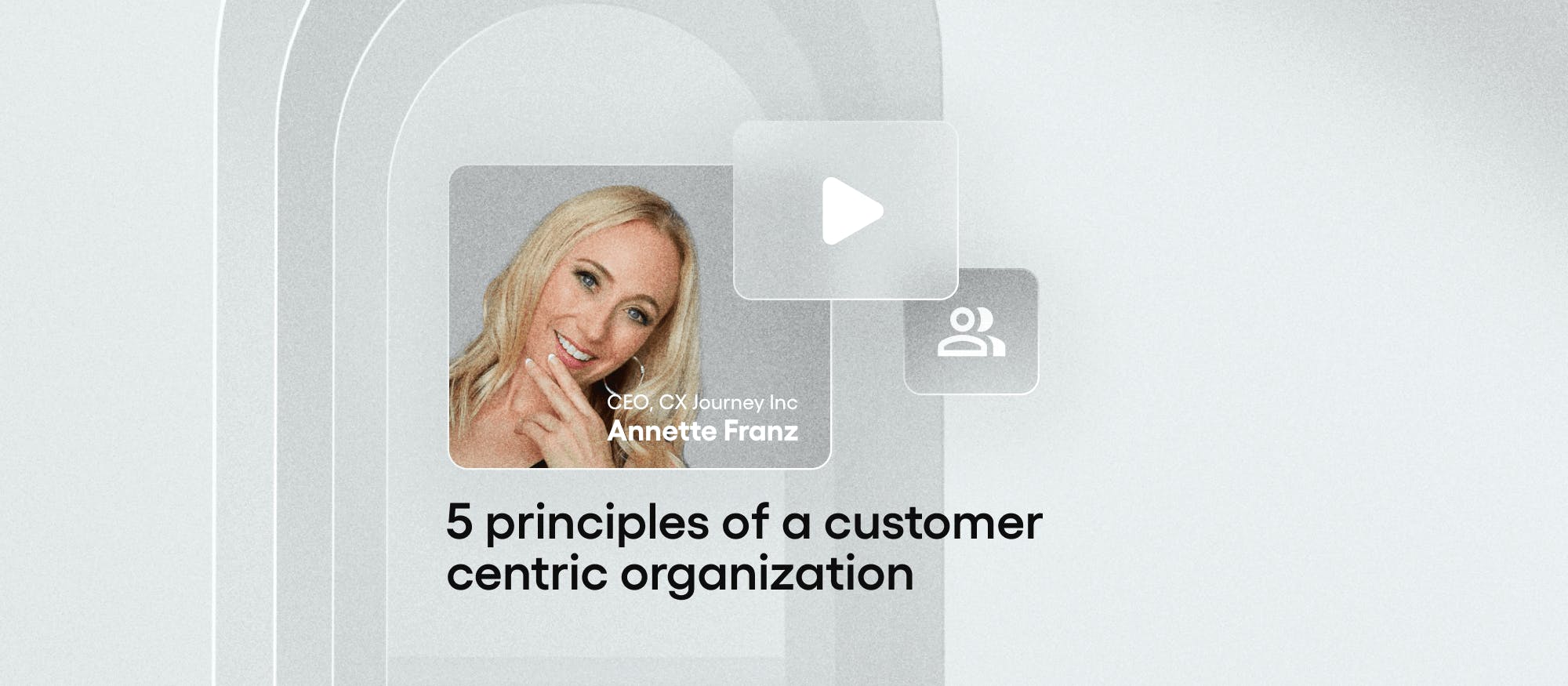5 principles of customer-centric organizations

This content has been repurposed from our 10 foundational principles of a customer-centric organizations webinar with Annette Franz.
Every person within your company influences customers, even if it’s not immediately obvious how.
From customer service to marketing to the less obvious accounting – reminding ourselves of the customers we’re helping makes work feel important. That’s why operating with a customer-centric culture is critical. Everyone should feel as though they are working toward a common goal: the customer.
Here are five principles of customer-centric organizations from expert Annette Franz.
You can also catch our webinar and more tips here.
1. Culture is the foundation
The foundation of any company is its culture. What keeps your team moving forward?
Culture is your organization’s core values plus behavior. If you want a customer-centric organization, you’re going to need some core values that are customer-driven that put the people first.
A customer centric culture is one where your company treats the customer with utmost importance, solving for them in everything you do.
Defining behaviors that are aligned with each of those core values, so that employees know what that core value means and what is expected of employees as a result of those core values, is also important. It’s not enough to just put your values on the website and have that be that.
Culture workshops can be a great way to get employees on board. Leadership should also be committing to aligning with values in their day-to-day.

Virgin Mobile UAE improved their CSAT with Sendbird Desk.
2. Employee experience will reflect in your customer experience
Without products and customers who buy them, there is no company. And without owners who invest capital, there is no future.
What about the employees?
If you’re placing employees too far down on the list of priorities, the people who design and build and sell and implement all of those products that you’re creating, it will reflect in your customer experience.
Employee experience is the sum of all the interactions that the employee has with their employer during the duration of that employment relationship, plus the actions and capabilities that enable them to do their job.
Employee experience is not about perks. It’s also not about employee engagement, which is the outcome of a great employee experience.
So what makes a great employee experience? Growth, development, recognition and appreciation are a start. If employees know that their leaders that care about communication, employee wellness, and wellbeing, they’ll be far more likely to achieve success within the organization.
3. Customer understanding
Customer understanding is the cornerstone of customer centricity.
The cornerstone is really the first stone that’s set in the foundation, and the foundation here is culture. So the cornerstone is that first stone that’s set, that’s customer understanding.
Everything else that we do flows in reference to that cornerstone. Discussions, decisions, design, innovation – to understand where your customer is headed so that you can build for it.
There are three ways to achieve customer understanding: Listening, characterizing, and understanding.
Listen to the feedback you get, plus the breadcrumbs of data that customers leave behind as they interact or transact with the brand.
Characterize your customers by interviewing them and developing your customer personas in detail.
To understand them further, create a journey map of the current state of the customer journey, what it will look like in the future, and develop the service blueprints. Service blueprints are the systems and processes behind the scenes that are helping to create or are facilitating the experience that customers are having.
4. Break down silos
A customer-centric organization is built on a collaborative culture, and in order to collaborate – you need to get rid of silos.
Everyone needs to work together to advance the cause. Your operating model should be built for internal and external collaboration.
Different collaboration tools can be extremely useful in breaking down silos. Making work transparent and easy to access eliminates file-sharing frustrations or missing context about why this project was initiated in the first place.
5. Outside-in, not inside-out
Expert Annette Franz discussed adopting the “outside-in, not inside-out” principle.
With inside-out customer thinking, you’re focusing on doing things you think are best for the customer without bringing the customer’s voice in.
The danger of the inside-out boat is that you’re sinking into a mess of maximizing shareholder returns rather than thinking about the benefits for the customer. Perhaps you’re improving internal efficiencies to the detriment of the customer or enacting cost-cutting measures that ultimately negatively impact the customer experience.
Outside-in customer thinking brings the customer’s voice inside your organization.
What does that mean? How can you incorporate the customer’s voice throughout the organization?
Jeff Bezos popularized the empty chair method. The idea is to physically represent your customer in meetings by leaving a seat, or two, for them. When the chair is present, the customer is too. It represents them and makes sure they’re always top of mind.
Customer-centric messaging delivered in-app
What’s more customer-centric than messaging with your customers directly in-app? Sendbird believes that messaging conversations inside a business’ mobile app will be the next frontier of relationship building and personalized interaction with customers.
It is the one medium that promises to achieve the holy grail for businesses: deliver personal experiences at scale while driving their own business goals.











